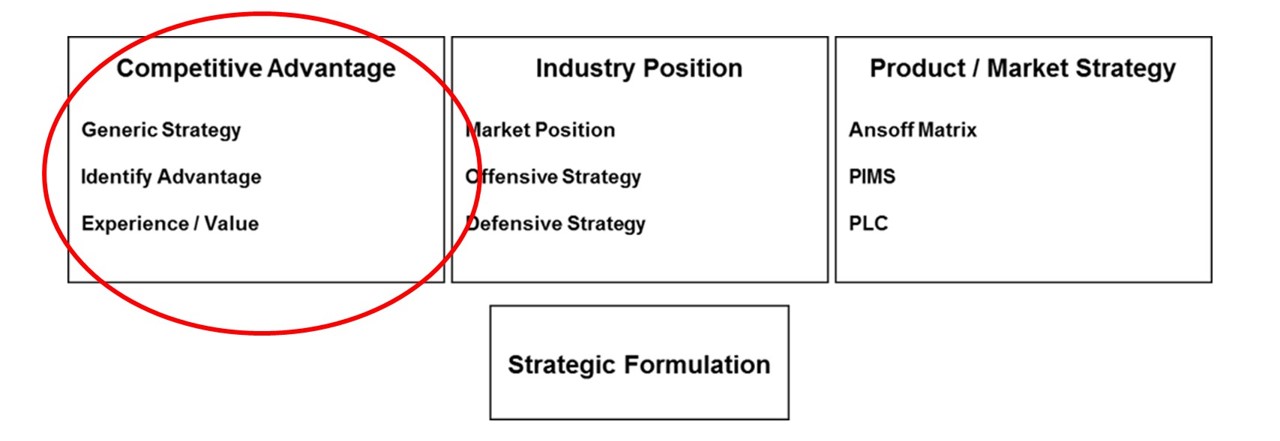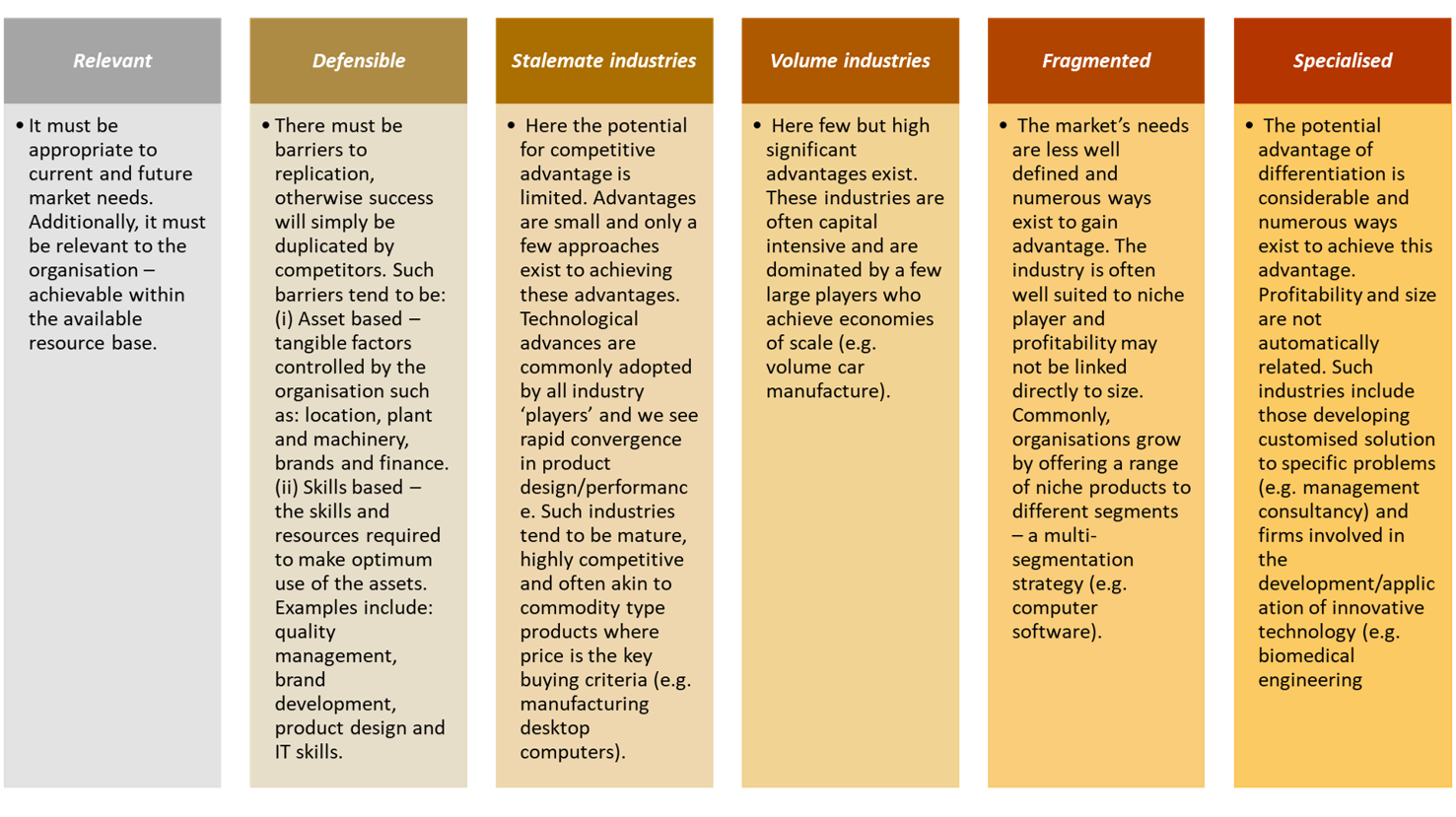
The notions of competitive advantage and marketing strategy are intrinsically linked. Competitive advantage is the process of identifying a fundamental and sustainable basis from which to compete. Ultimately, marketing strategy aims to deliver this advantage in the market place.
Porter (1980), identifies three generic strategies (fundamental sources of competitive advantage). These are: cost leadership, differentiation and focus.

Click here to view a video that explains Porter competitive strategies.
Cost Leadership
One potential source of competitive advantage is to seek an overall cost leadership position with an industry, or industry sector. Here the focus of strategic activity is to maintain a low-cost structure. The desired structure is achievable through the aggressive pursuit of policies such as controlling overhead cost, economies of scale, cost minimisation in areas such as marketing and R&D, global sourcing of materials and experience effects. Additionally, the application of new technology to traditional activities offer significant opportunity for cost reduction.
The basic drivers of cost leadership include:
Economy-of-scale: This is perhaps the single biggest influence on unit cost. Correctly managed, volume can drive efficiency and enhances purchasing leverage. Additionally, given large-scale operations, learning and experience effects (see later) can be a source of cost reduction.
Linkages and relationships: Being able to link activities together and form relationships can generate cost savings. For example, a ‘just-in-time’ manufacturing system could reduce stockholding costs and enhance quality. Forging relationships with external organisations is also vital. If industry partners were to share development and distribution costs, or activities were ‘outsourced’ to specialist operators, a substantial reduction in overheads is possible.
Infrastructure: Factors such as location, availability of skills and governmental support greatly affect the firms cost base. Given the development of information technology and the global economy, it is possible to have a worldwide infrastructure and selectively place activities in low-cost areas.
Differentiation
Here the product offered is distinct and differentiated from the competition. The source of differentiation must be on a basis of value to the customer. The product offering should be perceived as unique and ideally offer the opportunity to command a price premium. Will customers pay more for factors such as design, quality, branding and service levels?
The skills base is somewhat different from a cost leadership strategy and will focus on creating reasons for purchase, innovation and flexibility. Remember, it is often the perception of performance as opposed to actual performance that generates differentiation.
There are several ‘downsides’ to this type of strategy. Firstly, it can be costly with associated costs outweighing the benefits. Secondly, innovation and other initiatives can be duplicated by competitors.
Thirdly, customer needs change with time and the basis of differentiation can become less important as customers focus on other attributes. For example, in the car market, safety may now be seen as more important than fuel economy.
Common sources of differentiation include:
Product performance: Does product performance enhance its value to the customer? Factors such as quality, durability and capability all offer potential points of differentiation. Performance is evaluated relative to competitor’s products and gives customers a reason to prefer one product to another.
Product perception: The perception of a product is often more important than actual performance. Hopefully, the product has an enduring emotional appeal generating brand loyalty. This is commonly achieved through marketing communications (advertising, branding, endorsement, etc.) and direct experience of customer groups.
Product augmentation: We can differentiate by augmenting the product in a way that adds value. For example, high levels of service, after sales support, affordable finance and competitive pricing all serve to enhance the basic product offering.
Click here to view a video that explains differentiation vs cost leadership.
Focus
The organisation concentrates on a narrower range of business activities. The aim is to specialise in specific market segment and derive detailed customer knowledge. This focus, or niche, strategy can also generate the benefits of cost leadership or differentiation within a defined market segment. For example, it may be possible to obtain cost leadership within a chosen segment or that segment may regard your product offering as differentiated.
Success within a specialist niche can attract competitors – perhaps much better resourced. Additionally, the narrow business base means more susceptibility to downturns in demand from key customer groups.
A focus strategy is based on factors such as:
Geographic area: Using geographic segmentation allows a product to be tailored to local needs. The local association may offer the potential to differentiate the offering (e.g. champagne comes from a specific French region) and protect the market from larger predators. Another rationale for such segmentation is to serve markets too small or isolated to be viable on a large scale (e.g. rural communities).
End-user focus: It is possible to focus on a specific type of user as opposed to the entire market. Specialisation offers the opportunity to get ‘close’ to customers and have a better understanding of their needs (e.g. specialist hi-fi manufacturer). Additionally, within a narrow segment, the focused organisation may be able to offer the choice, service and economy-of-scale not available to more broadly-based competitors. This strategy often works by selecting specific points on the price/quality spectrum within a given market (e.g. discount food retailer).
Product/product-line specialist: The organisation focuses on a single product type or product line. Value is derived from the specialisation in terms of skills, volume and range (e.g. industrial power supplies).
Identifying Sources Of Competitive Advantage
Having an understanding of generic strategy makes it possible to consider how such general strategy can be translated into specific competitive advantage. A prerequisite to competitive advantage is sustainability. The organisation must be able to sustain its competitive advantage over the long term.
In order to be sustainable, the competitive advantage must be:

The most potent sources of competitive advantage can be summarised as:
|
Sources of Competitive Advantage |
Examples |
|
Actual product performance |
Robust, economic, easy to use |
|
Perception of product |
Brand image, product positioning |
|
Low cost operations |
Location, buying power |
|
Legal advantage |
Patents, contracts and copyright |
|
Alliances and relationships |
Networking, procurement |
|
Superior skills |
Database management, design skills |
|
Flexibility |
Developing customized solutions |
|
Attitude |
Aggressive selling, tough negotiation |